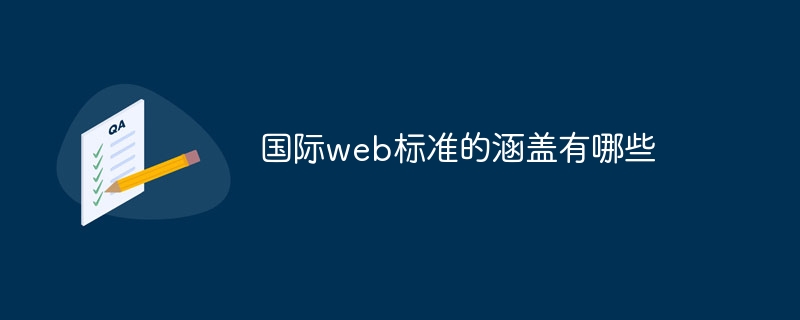Home >Common Problem >What do international web standards cover?
What do international web standards cover?
- 尊渡假赌尊渡假赌尊渡假赌Original
- 2023-12-25 14:38:09904browse
International web standards cover eight types: "HTML", "CSS", "JavaScript", "XML", "DOM", "SVG", "WebRTC" and "HTTP": 1. HTML, Markup language used to create web pages, which defines the structure and content of web pages; 2. CSS, used to describe the style and layout of web pages; 3. JavaScript, a scripting language used to add interactive and dynamic effects to web pages; 4. XML , a markup language for transmitting and storing data, and more.

# Operating system for this tutorial: Windows 10 system, Dell G3 computer.
International Web standards are mainly formulated and promoted by organizations such as W3C (World Wide Web Consortium), IETF (Internet Engineering Task Force) and ECMA (European Computer Manufacturers Association).
The following are some of the major Web standards developed by these organizations:
HTML (Hypertext Markup Language): The markup language used to create web pages, defining the structure of web pages and content.
CSS (Cascading Style Sheets): Used to describe the style and layout of web pages to give them better appearance and readability.
JavaScript: A scripting language used to add interactivity and dynamic effects to web pages.
XML (eXtensible Markup Language): A markup language used to transmit and store data, often used for data exchange and configuration files.
DOM (Document Object Model): an API (Application Programming Interface) used to access and manipulate the content and structure of HTML and XML documents.
SVG (Scalable Vector Graphics): An XML markup language used to describe two-dimensional vector graphics, which can achieve high-quality graphic display effects.
WebRTC (Web Real-Time Communications): A standard for real-time transmission of audio, video, and data between web browsers.
HTTP (Hypertext Transfer Protocol): A protocol used to transfer hypertext between clients and servers, and is the basis of Web communication.
JSON (JavaScript Object Notation): A lightweight data exchange format commonly used for data transmission between web applications.
Web Services: A set of standards and protocols for enabling distributed computing and application integration.
The above are some major international Web standards. Mastering these standards is very important for developing Web applications and designing web pages. Of course, there are many other standards and technologies, such as WebAssembly, WebGL, WebVR, etc. These technologies are constantly developing and improving, and developers need to continue to learn and update their knowledge.
The above is the detailed content of What do international web standards cover?. For more information, please follow other related articles on the PHP Chinese website!

